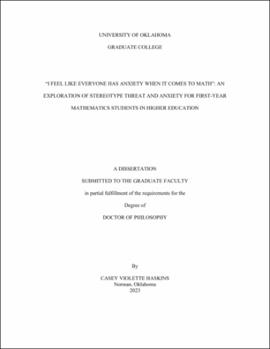| dc.description.abstract | Understanding of the relationship between anxiety and stereotype threat for students in first-year mathematics courses offers improvement for theoretical, methodological, and classroom practices surrounding the experiences of these constructs. This dissertation aimed to address the poor understanding of this relationship. Using a mixed methods participatory social-justice design (QUANT – QUAL), students’ performance, anxiety, and stereotype threat data were analyzed through a Control-Value Theory (CVT) and Situated Expectancy-Value Theory (SEVT) lens. Design and analysis were also considered through the Quantitative Critical Race Theory (QuantCrit) methodological lens. This study showed that gender-, sexuality, and income-based stereotype threat positively predicted achievement anxiety, while race-based stereotype threat nearly did so. Additionally, students’ anxiety did not predict their performance on the day data was collected, but their most recent math assessment score in their math course negatively predicted achievement anxiety during data collection. Some students identified connections of their emotions, identity, abilities, and changes during the assessment as additional information they wanted researchers to know. These results corroborate some research showing a correlation between achievement anxiety and stereotype threat and extend upon and challenge many previous studies which were not situated in real mathematics classrooms. Recommendations for classroom instructors include providing empowering help to students, providing threat nullification interventions without attempting to control students, and voting in elections to ensure that appropriate interventions remain options for educators. Challenges to future researchers include developing a situative component for CVT, reforming survey measures for stereotype threat, and increasing the use of open-response identity questions and other QuantCrit methodological considerations. | en_US |
